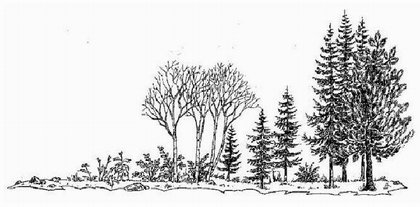 |
|

Using
Ecological Succession in Restoration
Ecological succession is the sequence
of changes that a biotic
community passes through before reaching its maximum possible development
within the climatic context of the regional landscape. This is usually
a self-sustaining condition often referred to as a climax
community. Ecological restoration assists an ecosystem
along this successional sequence towards a desired
future condition, which is usually at, or near, the climax
community (Gayton 2001). Damage generally reverts an ecosystem to
an earlier successional stage, or shifts it towards another type
of climax community.
By understanding the biotic community that your particular site
would naturally support, achievable and appropriate restoration
goals can be set. The Ministry of Forests' Biogeoclimatic Ecosystem
Classification system (see sidebar) is a useful tool in setting
restoration targets and understanding succession on many sites.
This system's site series descriptions provide lists of appropriate
plant species with which a planting program can be developed, in
order to kick-start the process of succession on damaged sites.
|
Climax is a complex process that is not entirely understood. Originally,
climax communities were regarded as the end result of a methodical,
linear
|
| process. Today we understand that natural succession is sometimes
unpredictable, and can follow several paths depending on site
conditions. A different climax community may result. It is also
important to note that not all ecosystems were at their climax
state before European settlement. Natural and anthropogenic
disturbances would have produced a mix of successional stages
across the pre-contact landscape (Gayton 2001). In general,
natural disturbance
regimes play an important role in ecosystem development,
and makes 'room' for some species not considered part of a 'climax'
community. Disturbance regimes may prevent an ecosystem from
reaching its climax community (Gayton 2001), and should be taken
into consideration when making restoration plans. For example,
excessive disturbance caused by over-grazing of grassland sites
will prevent the climax grass community from establishing, and
any restoration project should ensure that these types of degrading
agents are addressed as a first priority. |
|
|
Biogeoclimatic Ecosystem Classification system
|
|
The BEC system is an extremely useful
tool for describing and managing BC’s ecosystems. Every
BC restorationist should be familiar with how his or her
site fits into this classification scheme. For a more
complete description please see the Resources Section.
|
|
The complexity of ecological succession should not be a barrier
to action, but it should encourage restorationists to do their ecological
homework before launching into a project (Gayton 2001).

Dave Polster
Succession from bare ground (left) to
mature forest (right) is an important natural process that is fundamental
to ecological restoration. Re-establishment of natural successional
trends is often a goal of restoration projects.
|







